Don't Fence me In....Fencing and Malamutes 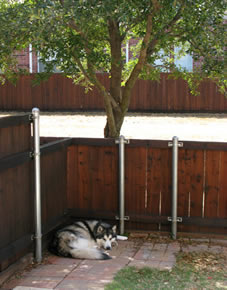
Your Malamute will require a sturdy fence...no other option will do. It's just something you need to budget for if you want an Alaskan Malamute. There are good fences and bad, but even a bad one is better than nothing. It's not so much to keep your Malamute IN, but to keep critters, children and small dogs OUT. Do you really want that lawsuit when your mal kills the neighbor's little dog (yeah, it was aggressive and deserved it, but I doubt you really want a lawsuit over it). Good fences make good neighbors. They also confine your Malamute's hunting to a limited area rather than the wildlife preserve next door or someone's cat.
Malamutes will also tend to fence fight with other same sex dogs next door so a fence that is solid is a real plus. It will save you cut paws or gashed noses when they decide to go at it with their rival.
In our neighborhood there is a neighbor with 2 dogs whose owners allow them to roam free. They routinely get in our trash, poop in our front yard (by our porch), and has attacked other dogs and even children. My Malamutes consider this dog and it's companion unworthy of living and would love to just kill it. I can't walk my dog in my own front yard without this dog harassing me, and he constantly teases my dogs in their fenced yard which leads to occasional fence "fights". I am constantly chasing them away. We've asked the owner to keep this dog home, but this owner doesn't seem to care, even when animal control asked them to be responsible Malamute owners. They feel a dog "needs" to run free. They are idiots and will likely lose another dog to traffic or running off because they are too lazy to fence their yard.
Owners run the risk of a ticket if the animal control arrests their dog, and they are liable for any damage the dog may cause when it's loose. Most states have leash laws or minimal dog containment laws. If it becomes annoying to walk the dog every time he needs to potty, some owners get lazy and start tying the Malamute in the yard (or letting it run loose). Neither is a good option for a Malamute. Although this keeps dogs at home, it often subjects them to teasing by children and other dogs, which can cause excessive barking and aggression. It also places them at risk of strangulation from the rope or chain. A dog on a chain is at a disadvantage should it be attacked by a trespassing dog. A chained Malamute over time may become aggressive and territorial.
The old adage "Good fences make good neighbors" is especially applicable when the neighbors own dogs. There are a plethora of fencing systems available to satisfy personal needs as well as zoning and esthetic requirements of everyone - including your Alaskan Malamute. In Europe, for centuries, walls were the most common fences. Americans were used to big open spaces and somewhat naively thought their dog would "just stick around" once it was "boundary trained". Unfortunately, that rarely works with a Malamute. Yes, fencing is expensive - but you can always fence a small area of say 10' by 10' to start and expand as finances permit. Ideally, make it longer if possible because it allows the Malamute to run and do his "wild thing" and burn off some energy.
Most Malamutes are quite content to stay in their yard (most of the time). Though occasionally some mals consider digging under fences (usually during the teen months - 6 months to 2 years). Most will not go over (unless you foolishly name the puppy "Superman"). A young puppy raised with a particular fence, even a fairly low one (4' minimum), will grow up with a respect for that fence and won't try to escape even when full grown. To prevent digging under, bury the bottom of the fence several inches in the ground or fill a narrow trench along the perimeter of the fence with concrete, patio blocks or chicken wire. If the dog digs holes along an established fence, fill the holes with rocks, concrete or patio blocks. Our fence is staked with tent stakes at the bottom at 2' intervals and that works just fine for most of the dogs.
Occasionally you'll find there are Alaskan Malamute escape artists - if you have one of those your fence should be of sufficient height to discourage jumping (usually at least 6'). If the fence isn't high enough, consider a jumping harness that prevents the dog from leaping, or install "barbed wire arms," those angled steel extensions for the top of the fence. We have heard of some owners electrifying the fence (assuming there are no children in the area) to keep a dog from climbing or digging out. Generally though, a 4' fence should be adequate for most Malamutes.
Beauty, budget, and the fact you are considering a Alaskan Malamute will affect the type of fence you choose - with a Malamute you want something sufficiently sturdy, not necessarily tall. A mal is more likely to try and dig out than climb out. I really would love for some homeowners groups to get sued because a child falls in a pond or a Malamute mauls a child when their only reason for not allowing fences is esthetics - it will ruin their yard and landscape. Safety should always come first! I think there is nothing more lovely than a rustic wood, stone or wrought iron fence anyway.
Most fencing is expensive; if you don't have a fence and are planning on getting a dog, add a fence to the budget. Buy the best looking fence you can afford. If what you want doesn't meet the zoning in your community, the time to fight it is BEFORE you get the dog.
Modular Fences (aka Kennels)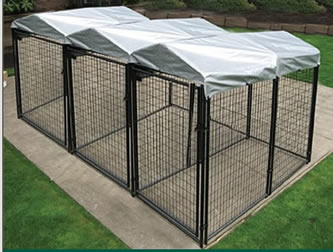
If your community doesn't allow a permanent fence, one way around this issue may be a modular fence that can be removed. Modular fences are useful in communities and subdivisions that prohibit any type of installed fencing. One solution may be to erect eight-foot chain link panels that clamp together and set on the ground. Their shape and weight hold them in place, although they may need to be anchored with stakes for a Malamute. The beauty is they are not permanent which is a plus for renters too. The panels can be disassembled and moved if necessary. You can also purchase complete, modular dog runs. These are usually in a single piece and can be set in the yard. They don't need to be anchored, are very strong, and are not permanent, thus avoiding many zoning regulations. Ideally you'll want it to be right off a porch or side garage door so that you don't have to TAKE the dog out to the enclosure. Believe me, after the 30th trip outside because the weather is cool and the Malamute is enjoying the cool weather, you'll wish you had easy access. Instead of linking them together to make "runs", you can always make one BIG kennel (or backyard). Just for the record, a kennel is ok for an O'Mal dog if there is no other option, but it can't be the dog's permanent home (the dog must live in the house, the kennel is for convenience when the dog can't be walked).
Hidden or Invisible Fencing
Hidden fences are sold under such names as Invisible Fence, Dog Watch, Malamute Stop, Dog Guard, etc. and to put it simply - they don't work for a Malamute. Their prey drive is too strong and pain threshold too high. In these systems, an electric wire is placed underground around the perimeter of the portion of the yard where the dog is to be confined. The dog wears a collar with a receiver and receives a warning beep when it nears the boundary and shock if it gets too close. Unfortunately Malamutes consider this a game - take a running leap and you're only shocked for a split second and you can STILL get that bunny. Once out, when the distraction is over, the dog may not come home because he knows he will get shocked for nothing (unless the bunny obliges and goes IN the yard). The receiver collars don't work well on heavy-coated dogs either.They may sound good if you don't want an ugly fence or your sub prohibits one - but it won't work for a Malamute. You simply need other options. Your dog will never be safe using this system and it's a total waste of money that you could have put toward a secure and safe solution. The dog requires some training for these systems to work, and as we all know, Malamutes are great at first but as soon as you let your guard down they'll be off and gone....forget the invisible fence. As as side, they also allow that aggressive neighbor's dog in the yard (he doesn't get a shock) to tease and taunt your Malamute - that is until the Malamute has had enough and kills him. No invisible fences. Period.
Chain Link 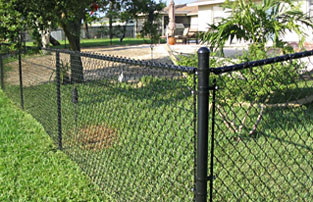
Chain link is one of the most common fences. This series of pipe support posts and small diamond-shaped, heavy-gauge wire fabric is very strong. Chain Link which is sometimes called hurricane fencing in some areas is an economical way to enclose an area. Chain link fencing comes in rolls from 25' to 100' long and 4' to 6' high, with prefabricated gates up to 5' wide. If you don't like the silvery look of the bare fence, it's available with a weather resistant vinyl coating, usually green or brown. Chain link is a good choice for keeping Malamutes in or other creatures out. Most professional kennels use chain link in their fencing and dog runs. It is available in a variety of heights - if you have a choice go for at least 6'. Zoning laws seem to allow its use where many other forms of fencing are prohibited. It hardly obstructs the view and is a strong deterrent to intruders. Because of it's diamond shaped hole, it's more difficult than some times of fence for a dog to climb. Chain link is fairly expensive, but still less than most wood or masonry fences. It lasts longer than many other types of fences and can be painted. However, children can easily tease a dog confined by a chain link fence. A 4' fence is adequate for MOST Malamutes, but if you get a jumper even 6' may not be tall enough. Superman is notorious for putting his feet into the holes and pushing himself over. We had a 4' fence - and it's no longer adequate because he's such a jumper/climber - but for the rest of the dogs, it was fine. If you really must use a 4' fence consider coyote rollers at the top. It makes the fence difficult to climb.
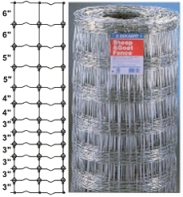 Farm Fence
Farm Fence
A less expensive option that is similar to chain link, particularly if posts are sunk into the ground and cemented in. If you just use the stakes that come with it, it's not very secure for a Malamute, but is better than nothing. How well it works depends on the thickness of the wire. Go for the heaviest you can find. Farm fence or sheep fence is the cheapest fence and fabric that will restrain a dog. Often the fabric is loosely woven, narrow-gauge wire with larger rectangles at the top and smaller ones at the bottom. It comes in various heights and is installed over brace posts and t-posts. It must be stretched for strength as it is installed. If possible, get a stronger gauge and smaller opening. Puppies have been known to get their heads caught in the larger openings. Another kind of farm fence is chicken wire. This works well as a barrier for digging UNDER a fence, or as a backing to open (such as split rail) fences but is really not very sturdy. This can be a good option for a temporary Malamute fence (such as when you move and need to put up a more permanent fence but need time to do it).
Snow fence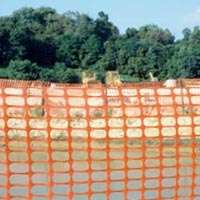
Snow fence is one of the cheaper options. It is composed of low-gauge wire fabric of two-inch by four-inch rectangles. It is available in various heights and is installed on a series of brace posts and t-posts. The fabric must be stretched when it is installed to ensure added strength. This may be adequate for a small dog, but will not contain a Malamute except maybe the youngest puppy (who will probably go under it). As a temporary measure, where the dog is supervised outside it may be ok until a more substantial fence is put in. Be aware that the lower gauge wire of this fence can rust through, and plastic can rip and be chewed, so periodic checking for holes is necessary. A Malamute can probably rip right through a snow fence if he wanted to - even a young puppy - so I wouldn't recommend using this at ALL unless as a VERY TEMPORARY arrangement and you are going to be outside with the dog each and every time.
Wrought Iron/Polymer Fencing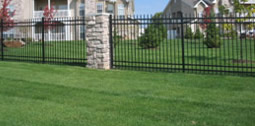
Wrought iron or Polymer Fencing that recreates the classic look of wrought iron is a beautiful fencing and is usually ok for a Malamute as long as it is tall enough and gated. Make sure the slats are narrow enough a dog can't get his head caught. The down side is that like chain link, children can put their hands through the fence. Low-maintenance, easy-to-install and rust-free, this fencing system is a great alternative to iron. It also makes it harder for the Superman's of the world to get a foothold and push themselves over!
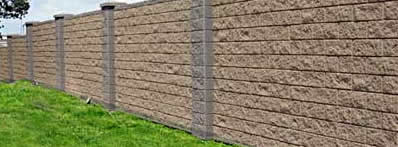 Masonry Fencing
Masonry Fencing
My favorite fencing is masonry fencing - whether stone, brick or concrete these are impossible to scale, difficult to dig under and provide a "fence fighting" barrier to other neighborhood dogs. Probably the most expensive and time consuming to build, they will last for eternity. Maintenance is almost unnecessary (unless water gets into the stone or brick causing the mortar to fall out). I think in all, this is an excellent fence for a Malamute if tall enough,
Vynal Fencing
Vinyl Fencing is a relatively new, maintenance-free type of privacy fence. It looks like wood, but needs less maintenance and can be quite strong. Vinyl fencing isn't subject to rot, fading, nor does it need painting. Vinyl is a good choice for an attractive, easily-maintained fence system, but the plastic isn't all that strong - so may not hold in a determined Malamute. It also tends to shatter in cold climates so with a Malamute jumping against it, I doubt it would last all that long and be worth the cost. Get something at least 4-5' tall.
Bamboo Fencing
Bamboo is also a new type of fence...being as it's fairly thin, I really don't think it would hold in a malamute - especially a determined one that would just mow it down. Your money is better spent elsewhere. Unless it has an extremely strong foundation structure, I just don't see how this would be workable. If you decide to use it for a temporary solution, be out there with the dog and supervise closely.
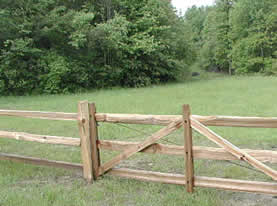 Split Rail Fencing/Post and Rail Fencing
Split Rail Fencing/Post and Rail Fencing
Split rail fences provide a much more open view and are not adequate to contain a Malamute. They usually consist of wooden brace posts joined by two or more wooden cross rails. This fence looks nice and is often incorporated into professional landscape designs but it's inadequate to contain much of anything without chicken wire or some sort of backing. Split rail fences provide a very strong base, but wire fabric must be added inside the fence to contain a Malamute.. Also, split rail fences tend to be only 3 ft. tall which is not adequate either. The rails are available either split or round in lengths from 8' to 11'. The posts range can hold either two or three rails. (Make sure the wire fabric is added inside the fence or the dog may be able to climb to rails.) The fabric becomes almost invisible, particularly if shrubbery is planted along the fence line and can be sunk into the ground creating a dig-proof barrier. Cost is midway between expensive solid fences and cheaper fabric fences. It combines well with other fencing and can be used to dress up the more visible portions of a fenced yard. If you have a jumper, don't bother.
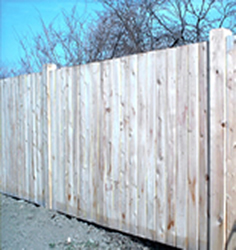
Wood Privacy Fence
Wood Panel Fencing is commonly used as a decorative means of providing privacy for homes in neighborhood settings. Most subdivisions will allow this kind of fencing if cleared with the homeowner association in advance. It's sturdy and discourages fence fighting with a dog next door. The wood fence panels usually come in 8' sections, 4' to 6' tall. The panels are available with either dog-eared or pointed pickets. You can easily match the fence to your landscape with stain or paint. The most difficult thing about erecting these fences as because they are heavy, posts must be set into concrete in the ground. Make sure the fence is low enough that the Malamute can't wiggle under. If the fence isn't tight to the ground, the Malamute may be more likely to test to see if he can dig out. A solution we found is to lay a row of chicken wire just under the grass, some use railroad ties lain at the base...it prevents digging near the fence line. This is probably one of the best options.




